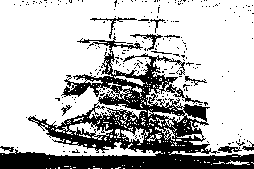 |
FAMOUS SHIPS |
 |
FAMOUS SHIPS |
The "MIDDLESEX"
This was the second ship of the same name. The first ship was a wooden built vessel, both constructed and owned by George Marshall & Sons, of London. The second MIDDLESEX, built by Barclay, Curle & Co., was of iron construction. She was the largest ship in the Marshall fleet, being launched in November, 1884. Her gross tonnage was 1,824, net tonnage of 1,742. She had dimensions of: Length, 268 feet 4 inches; breadth, 38 feet 8 inches; depth, 23 feet 6 inches.She had a good sail plan with crossed mainskysail and double fore and main topgallant sails, but a single mizen topgallant sail. This latter was the heaviest sail to handle and furl in the ship. Being a Barclay, Curle full-rigged ship, the MIDDLESEX was fitted with a spike bowsprit and carried no spanker- boom. The dimensions of the spars are indicated as: foremast, 147 feet; mainmast, 162 feet; mizen, 129 feet. The top-gallant, topsail and lower yards were the same size on both fore and main, the lower yards measuring 88 feet, with an additional 5 feet for the yard-arms. The crossjack yard was 73 feet.
Captain George Janes took command of the MIDDLESEX from the time of her launch until she left the George Marshall & Sons ownership. He was a very fine ship master -- one of those men who always get the best out of a ship, a bold sail-carrier, who was not afraid to hang on to his canvas in heavy weather, and yet rarely lost even a light weather kite. He was a strict disciplinarian and, like all sailors who would stand no nonsense, was much respected by his crews. The MIDDLESEX was his last command, as her retired from the sea when he left her.
